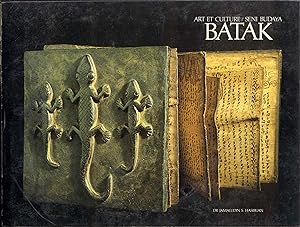Hasibuan Dr Jamaludin S (1 results)
Product Type
- All Product Types
- Books (1)
- Magazines & Periodicals
- Comics
- Sheet Music
- Art, Prints & Posters
- Photographs
- Maps
-
Manuscripts &
Paper Collectibles
Condition
- All Conditions
- New
- Used
Binding
- All Bindings
- Hardcover
- Softcover
Collectible Attributes
- First Edition
- Signed
- Dust Jacket
- Seller-Supplied Images
- Not Printed On Demand
Seller Location
Seller Rating
-
Hardcover. Condition: Very Good. Dust Jacket Condition: Fair. CX1 - A hardcover book in very good condition in fair dust jacket that is mylar protected. Dust jacket has wrinkling, chipping, and peeling on the clear plastic film on the edges, corners and some sides, scattered scratches, rubbing, scuffing, and some stains, scattered bubble crease on the back, soiled with stains on the opposite side of the back, spine, and front left side, light tanning, and shelf wear. Book has some light stains on the page edges, lightly moisture soiled on some edges and sides, tanning, and light shelf wear. Text in French. BATAK - Art et Culture / Seni Budaya. 8.5"x11.25", 312 pages. Satisfaction Guaranteed. Batak is a collective term used to identify a number of closely related Austronesian ethnic groups predominantly found in North Sumatra, Indonesia who speak Batak languages. The term is used to include the Karo, Pakpak, Simalungun, Toba, Angkola, and Mandailing which are related groups with distinct languages and traditional customs (adat). Linguistic and archaeological evidence indicates that Austronesian speakers first reached Sumatra from Taiwan and the Philippines through Borneo or Java about 2,500 years ago, and the Batak probably descended from these settlers. While the archaeology of southern Sumatra testifies to the existence of neolithic settlers, it seems that the northern part of Sumatra was settled by agriculturalists at a considerably later stage. Although the Batak are often considered to be isolated peoples thanks to their location inland, away from the influence of seafaring European colonials, there is evidence that they have been involved in trade with other neighbouring kingdoms for a millennium or more. The Bataks practiced a syncretic religion of Shaivism, Buddhism and local culture for thousands of years. The last Batak king who fought valiantly against Dutch imperialists until 1905 was an Indonesian Shaivite king. The Batak may be mentioned in Zhao Rugua's 13th-century Description of the Barbarous Peoples (Zhu Fan Zhi), which refers to a 'Ba-ta' dependency of Srivijaya. The Suma Oriental, of the 15th century, also refers to the kingdom of Bata, bounded by Pasai and the Aru kingdom. Based on this evidence, the Batak may have been involved in procuring important commodities for trade with China, perhaps from the 8th or 9th centuries and continuing for the next thousand years, with Batak men carrying the products on their backs for sale at ports. It has been suggested that the important port of Barus in Tapanuli was populated by Batak people. A Tamil inscription has been found in Barus which is dated to 1088, while contact with Chinese and Tamil traders took place at Kota Cina, a trading town located in what is now northern Medan that was established in the 11th century, and comprising 10,000 people by the 12th century. Tamil remains have been found on key trade routes to the Batak lands. These trading opportunities may have caused migration of Batak from Pakpak and Toba to the present-day Karo and Simalungun 'frontier' lands, where they were exposed to greater influence from visiting Tamil traders, while the migration of Batak to the Angkola-Mandailing lands may have been prompted by 8th-century Srivijayan demand for camphor. The Karo marga or tribe Sembiring "black one" is believed to originate from their ties with Tamil traders, with specific Sembiring sub-marga, namely Brahmana, Colia, Pandia, Depari, Meliala, Muham, Pelawi, and Tekan all of Indian origin. Tamil influence on Karo religious practices are also noted, with the pekualuh secondary cremation ritual being specific to the Karo and Dairi people. Moreover the Pustaka Kembaren, an origin story of the Sembiring Kembaren suggests linkages with Pagarruyung in Minangkabau Highlands. From the 16th century onward, Aceh increased the production of pepper, an important export commodity, in exchange for rice, which grew well in the Batak wetlands. Batak people in different areas cultivated either sawah (wet rice fields) or ladang.


